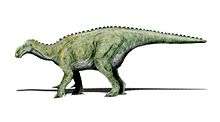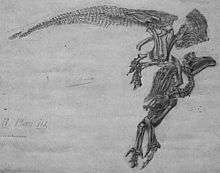1825 in paleontology
| |||
|---|---|---|---|
|
Paleontology or palaeontology (from Greek: paleo, "ancient"; ontos, "being"; and logos, "knowledge") is the study of prehistoric life forms on Earth through the examination of plant and animal fossils.[1] This includes the study of body fossils, tracks (ichnites), burrows, cast-off parts, fossilised feces (coprolites), palynomorphs and chemical residues. Because humans have encountered fossils for millennia, paleontology has a long history both before and after becoming formalized as a science. This article records significant discoveries and events related to paleontology that occurred or were published in the year 1825.
Dinosaurs
Newly named dinosaurs
Data courtesy of George Olshevsky's dinosaur genera list.[2]
| Name | Novelty | Status | Author(s) | Age | Unit | Location | Notes | Images |
|---|---|---|---|---|---|---|---|---|
|
Gen. nov. |
Valid |
Wessex Formation |
In a presentation to the Royal Society of London, Mantell reports his conclusion that the newly named Iguanodon is a new giant herbivorous reptile. A formal description was published in writing later in the year.[4] The original type species, I. anglicus (an amended form of the original I. anglicum) was only named in 1829 by Friedrich Holl. This created a proper binomial.[5] Later in 1881, a second species, I. bernissartensis, was named by George Albert Boulenger. This species then became the type species as I. anglicus and the original Iguanodon material were moved into the genus Therosaurus.[6] |
| ||||
Newly named birds
| Name | Novelty | Status | Authors | Age | Unit | Location | Notes | Images |
|---|---|---|---|---|---|---|---|---|
|
Larus toliapicus [7] |
Sp. nov |
Valid |
E. Koenig |
Early Eocene |
Ypresian, MP 8, London Clay Formation |
Described as a genus of Laridae, but transferred to a new genus Halcyornis Owen, 1846, and placed in the new family Halcyornithidae Harrison et Walker, 1972, This family was placed in synonymy with the family Pseudasturidae Mayr, 1998, by Mayr, 2009, stem Psittaciformes. This is the type species of the genus Halcyornis. |
References
- ↑ Gini-Newman, Garfield; Graham, Elizabeth (2001). Echoes from the past: world history to the 16th century. Toronto: McGraw-Hill Ryerson Ltd. ISBN 9780070887398. OCLC 46769716.
- ↑ Olshevsky, George. "Dinogeorge's Dinosaur Genera List". Retrieved 2008-08-07.
- ↑ Mantell, G.A. (1825). "Notice on the Iguanodon, a newly discovered fossil reptile, from the sandstone of Tilgate Forest, in Sussex". Philosophical Transactions of the Royal Society. 115: 179–186. doi:10.1098/rstl.1825.0010. ISSN 0261-0523. JSTOR 107739.
- ↑ Farlow, J.O.; Brett-Surmann, M.K. (1999). The Complete Dinosaur. Indiana University Press. p. 9. ISBN 0-253-21313-4.
- ↑ Holl, F. (1829). Handbuch der Petrifaktenkunde: Ouedlinberg. Dresden: P.G. Hilscher. 1. OCLC 7188887.
- ↑ Paul, G.S. (2008). "A revised taxonomy of the iguanodont dinosaur genera and species". Cretaceous Research. 29 (2): 192–216. doi:10.1016/j.cretres.2007.04.009.
- ↑ E. Koenig (1825). Icones fossilium sectilis: 1–44.

